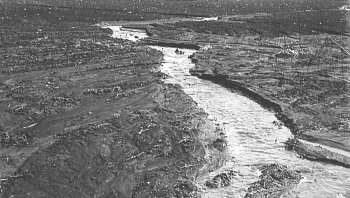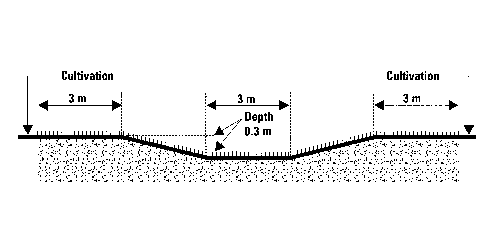| | When to construct a waterway | Shape of Grassed Waterways | Size of the waterway | Gully repair | Seeding the waterway | Maintaining grassed waterways
Grassed waterways are broad, shallow channels that carry surface runoff with a minimum of erosion. Natural waterways are easily seeded to forages, either grass or grass-legume mixtures, to prevent severe soil loss and gully formation.
These waterways are constructed with uniform grades to gradually carry water down slopes and with flat bottoms to spread the water out and slow it. The vegetation in the channel retards the flow and provides a more durable channel surface that resists the soil cutting action of water.
With proper fertilization and maintenance, a grassed waterway can be a productive forage area. Reshaping and grassing a gully allows easy access and crossing for machinery.
Grassed waterways also help direct the flow of water to a suitable outlet. These waterways should be designed and constructed to handle the required flow of water.

Runoff following rainstorms and spring snowmelt removes tons of valuable topsoil from unprotected farmland. Small rills, if not properly repaired and protected, can become deep gullies.
When to Construct a Waterway
The grassed waterway should be constructed in late spring to ensure a good growth of grass before the following spring runoff.
Shape of Grassed Waterways
A grassed waterway should be saucer-shaped (Figure 1). This shape spreads the water, slows its velocity, and reduces its erosive force. It also permits machinery to cross the channel and allows easier mowing.

Figure 1. Cross-section of a typical grassed waterway
The side slopes should rise no more than 25 per cent (one metre vertical to four metres horizontal). Side slopes can be flattened to allow easier crossing by farm equipment. The standard bottom width is three metres, which allows construction with a grader or scraper. The bottom of the waterway should be kept level during shaping and seeding, so runoff will be spread evenly over the bottom.
Size of the Waterway
The waterway must have sufficient width and depth to accommodate the expected runoff volume. The runoff volume is influenced by the watershed area, the rate of snowmelt, the duration and intensity of rainfall, and also by the vegetative cover and soil type of the watershed.
A waterway with a three metre bottom width should be constructed with a minimum depth of 30 centimetres. If slopes are steep and severe gullying is evident, an engineering survey and design may be required. For more information or advice, contact your local Agricultural Fieldman.
Gully Repair
Various types of equipment can be used to repair gullies. A road grader or track type (crawler) tractor with a dozer blade is typically used. The grader or dozer blade can be tilted to shape the side slopes, and the blade is the proper width for cutting the channel bottom. A motor or pull type scraper is the most efficient piece of equipment when material must be hauled for any distance between cut and fill areas. A scraper is also useful for stripping, stockpiling and respreading topsoil. A backhoe or trackhoe can also be used for channel construction, but they are usually slower than other types of equipment. Some municipalities make their equipment available for this type of work, or they may rent equipment to landowners who wish to do the work themselves.
Before construction, brush, rocks and other debris should be removed from the work area. Brush must not be buried beneath the waterway, as this will cause uneven settling and subsequent erosion. Topsoil should be removed from the working area and stockpiled, then replaced after construction to provide a good seed bed material. Sod should first be broken with a disk to make stockpiling and spreading easier. If a grader or cat is being used, the topsoil can be windrowed at the side of the work area.
The working area should be at least 20 metres in width to provide sufficient fill to work with. If the gully is large, fill may have to be obtained from a borrow area to provide the required volume. When excess material is produced by channel excavation, it can be "wasted" in low areas near the project. Topsoil from the low areas should first be stripped, and then replaced after the waste material has been levelled.
Gullies should be filled gradually, in lifts of about 0.3 metres. The fill should be packed with heavy rubber-tired equipment as each layer is added. Good compaction is essential to stabilize the fill and prevent settling and subsequent erosion. The waterway depth and width should be measured frequently during construction to ensure they are the correct dimensions. Care should be taken to ensure the channel bottom is flat and constructed to grade. This approach prevents ponding and distributes the water evenly. Be sure to allow extra depth to permit spreading the topsoil after construction. Excess soil should be spread away from the sides, so runoff from adjoining land can flow into the waterway.
It's useful to mark the channel with stakes showing the depth of cuts and fills which have to be made. The depth of cut/fill can be measured from the top of the stake and painted on the stake with a can of spray paint. This will allow the operator to easily see the amount of cut/fill while he is working. The top width of the channel can also be staked. This will be helpful when the side slopes are being shaped. The cut/fill stakes should be offset from the center, to allow construction of the channel bottom without moving the stakes. When the bottom of the channel is constructed to grade, the sides are graded to the ground surface at the stakes which mark the top width. This will give the correct side slopes. The channel should be measured with a level to ensure it has the required dimensions.
Seeding the Waterway
Suitable vegetation is important in ensuring a durable permanent cover for the waterway. The topsoil should be respread over the waterway, then levelled and harrowed to provide a flat bottom and a good seed bed. Seeding should be done across the waterway to further slow the water.
A mixture of grasses and legumes that establish quickly, provide a good surface cover and deep-rooted sod is essential. A cover crop such as fall rye is recommended to protect the waterway before the grass becomes established. Since fertility may be low on a newly constructed waterway, a heavy application of fertilizer is a good idea. Contact your Agricultural Fieldman for advice on the most suitable seed mixture for your area.
Maintaining Grassed Waterways
- The waterway should be inspected after heavy rains and spring runoff. Bare or eroded spots should be repaired and reseeded.
- The waterway should be mowed regularly to improve sod density. Tall growth should not be left over winter to trap snow, which will block the flow of spring runoff.
- Snow plowing the waterway just before spring runoff may be necessary to clear the channel and prevent misdirection of the runoff.
- The waterway shouldn't be grazed during the first two years, and never when it's wet and soft.
- Rodents in the waterway should be controlled, as their digging will weaken the sod and may cause erosion.
- Don't use the waterway as a field road. Frequent traffic may damage the sod or cause ruts which will concentrate the water flow and eventually result in erosion.
- Do not leave open furrows parallel to the edge of the waterway; they may erode and form a new gully.
- Regular fertilizer application will assure vigorous grass growth and adequate erosion protection.
- Weeds in the waterway should be controlled to prevent them from spreading onto surrounding fields.
Source: Agdex 573-6. |
|